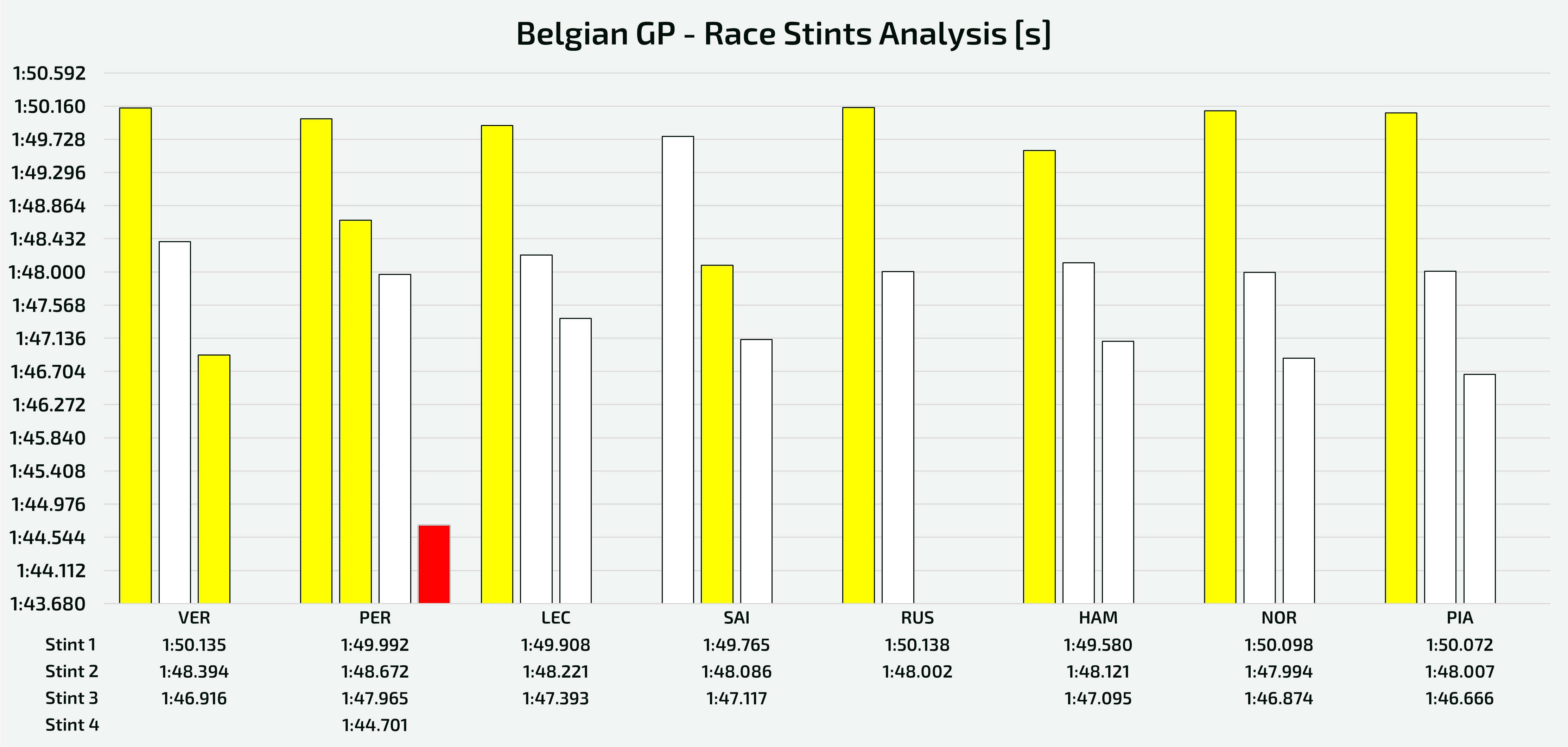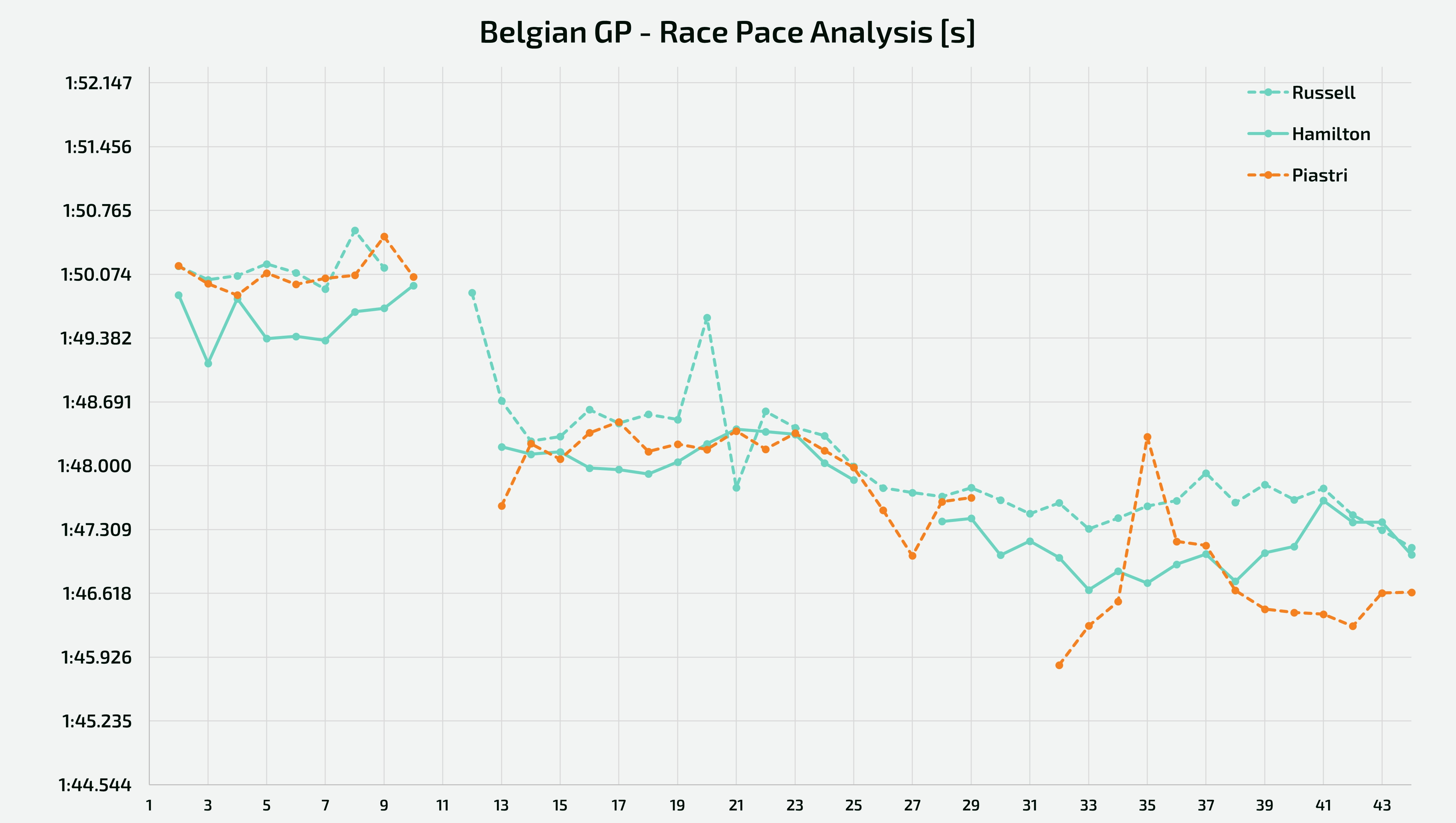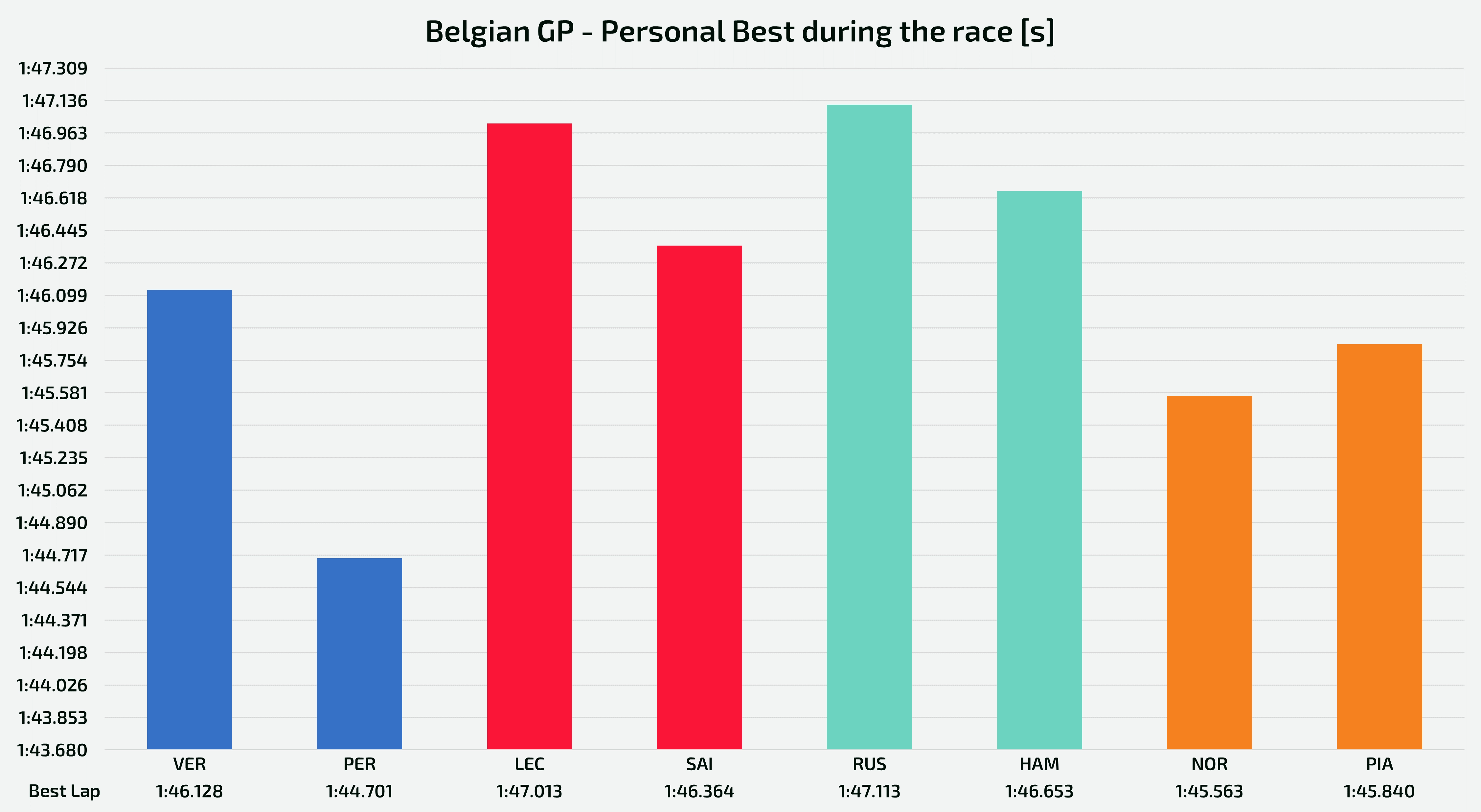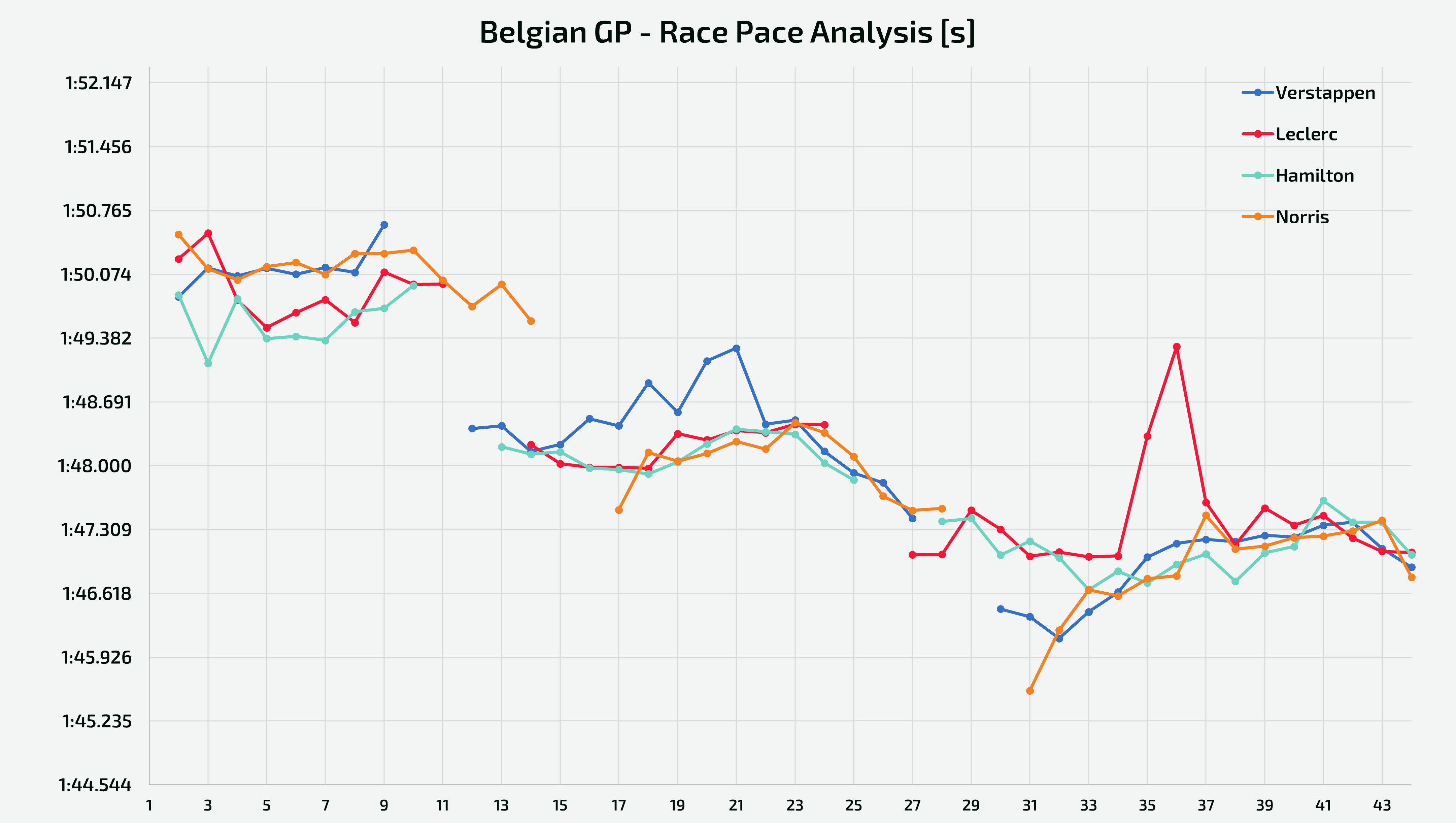
Spa: Russell looked set for victory, but disqualification gives Hamilton the win!
Formula 1 never ceases to amaze us, and in the last race before the summer break literally everything happens: at Spa George Russell wins by making a crazy one-stop strategy work, then his Mercedes W15 is found to be 1.5 kg underweight compared to threshold of 798.0 kg prescribed by the Technical Regulations. Race win then goes to Hamilton, with Piastri and Leclerc completing the podium...
New document: Doc 46 - Final Race Classification
— FIA F1 Documents Bot (@fiadocsbot) July 28, 2024
Published on 28-07-2024 19:56 CEThttps://t.co/7OXqAYQxAn#F1 #Formula1 #FIA #BelgianGP 🇧🇪 pic.twitter.com/C0u8QCtz5M
An unpredictable Formula 1: Mercedes returns to the old floor and finds itself quickest in Belgium
At the end of yesterday's qualifying we talked about the technical situation at Mercedes, explaining how the introduction of a new floor at Spa had brought back the annoying porpoising that the Brackley team has had to deal with for much of this "ground effect" era in Formula 1. This then forced the technicians led by Toto Wolff to return to the old floor specification for the rest of the weekend, leaving us - after the wet qualifying - with big doubts about what the potential on dry track conditions of Russell and Hamilton's W15s could have been.
Sam Bloxham / Motorsport Images
Amazingly, 24 hours later we're here to comment on what could have been a one-two, had it not been for the disqualification that the FIA stewards (correctly) handed to George Russell after his car was found to be underweight in post-race scrutineering.
New document: Doc 44 - Infringement - Car 63 - Technical non-compliance (Weight)
— FIA F1 Documents Bot (@fiadocsbot) July 28, 2024
Published on 28-07-2024 18:53 CEThttps://t.co/Ofyhig7cyC#F1 #Formula1 #FIA #BelgianGP 🇧🇪 pic.twitter.com/yQoNAhvQsv
Beyond what we can describe as an judgment error by the Mercedes engineers, the performance of the English-German team was certainly not predictable when the lights went out for the start of the race at Spa: let's try to understand with the data how the W15 went back to being as strong as in Silverstone without any early signs...

Belgian GP - Analysis of the stints completed by the first 8 drivers at the finish line
At the start of the race, Hamilton immediately gained second place on Perez, and after just 3 laps it was Leclerc's turn to give up the lead in favour of the Englishman: the average laptimes in the first stint speak for themselves, with a gap of almost half a second per lap on the most accredited rivals of McLaren, Red Bull and Ferrari (the comparison with Sainz in the first stint, who had started with the Hards on a different strategy, isn't that useful).
In the second stint, while maintaining the lead despite an attempted undercut by Leclerc which failed miserably on lap 24, Lewis' pace slowed down, returning to the levels of the two McLarens (1'48"1 for him, against 1'48"0 for the two papayas). The two Red Bulls were even slower, with Verstappen completing the middle stint on the Hards with an average pace of 1'48"4.

Belgian GP - Analysis of the race pace held by Russell, Hamilton and Piastri
At that point in the race, the driver with an "off-sync" strategy became Russell, who for a few laps had been asking his track engineer to switch to a single pitstop strategy: a real feat that was achieved through perfect tyre management and a speed second only to Hamilton today, with the difference that his average laptimes (1'50"1 on the Mediums in the first stint, 1'48"0 on the Hards in the second) are the result of the need to complete a substantial amount of laps to bring his W15 to the finish line in first position.
Zak Mauger / Motorsport Images
Delving a bit more into the post-race DSQ, we cannot rule out the possibility that the lower weight of the W15 number 63 at the finish line was caused by having made only one pitstop: as we know, in F1 you are always very close to the limit in terms of minimum weight, so having performed a very long final stint certainly caused greater wear of the tyres, therefore an accentuated thinning of the tread; if we add to this that at Spa it is common practice not to do the in-lap after the chequered flag in its entirety, instead cutting Turn 1 and tackling the pitlane in the wrong direction, George was also unable to collect marbles, those small pieces of tyre left by the cars during the race on the outside of the racing line. A trick that everyone uses on the in-laps, as the hot tyres attract these marbles until they form a proper layer around the tread, with the advantage of increasing the overall weight of the single-seater itself.

Belgian GP - Personal best laptime for each of the top 8 finishers
Returning to the analysis of the data of this race, the histogram of the personal best laptimes makes us understand that in the final stages the two Mercedes drivers weren't the fastest overall (just take a look back at the graph of each stint, where we can see that Hamilton's 1'47"1 is bettered by Norris's 1'46"9 and Piastri's 1'46"7, the best in the final laps). Curiously, in the final laps Hamilton, despite being in Russell's DRS zone, was unable to overtake him: the reason is that the latter still had some "rubber" to use in the traction zones, especially exiting the Source (Turn 1) before Eau Rouge - Raidillon and the long Kemmel straight; on the other hand, surprisingly, Russell's personal best was set on the very last lap!
A missed opportunity for Piastri, very quick in the final stages!
The race of the two McLarens sounds a bit like a missed opportunity especially for Oscar Piastri: already from the beginning of the race, the race start dynamics had placed the two MCL38s in P4 with Oscar and in P7 with Lando, who ran wide into the gravel trap outside the Source, thus losing 3 positions.
Sam Bloxham / Motorsport Images
The first two stints of Piastri, however, were nothing special if we think about the pace to which McLaren had accustomed us in the last 5/6 Grand Prix: even after overtaking the slower Perez on lap 13, the Australian's laptimes were never as competitive as Hamilton's. It was in the last stint, tackled on Hard tyres by almost everyone, that Melbourne native's performance came back to life... A shame that his second pitstop lasted 4.4 s due to a mistake, when he overshooted his spot in the pitlane: the reaction of his mechanics' crew inevitably made him lose crucial race time, which was difficult to recover even with a hellish final stint.
Zak Mauger / Motorsport Images
The result at the finish line is still an excellent second position, which after the victory in Budapest sees him overtake Sainz in the Drivers' Standings, while getting closer to the other Ferrari of Leclerc. Norris' race outcome was even worse, because after the aforementioned initial mistake, despite a McLaren in great shape down the straights of Spa, was unable to get the better of his rival in the World Championship, that Max Verstappen who, achieving a fourth place, preceded him by a hair's breadth at the finish line... It's sad to say, but with the performance level that the Woking team is providing its drivers, the number of missed wins continues to grow race after race. And with it, the gap in the standings from the World Champion shows no signs of a reduction...
Verstappen very close to the podium, wonderful damage limitation against Norris!
After the two amazing comebacks that in 2022 and 2023 had seen Max climb up to the victory in Spa, this year the balance of power between the various teams hasn't allowed an equally prodigious recovery from the starting P11. Despite this, thanks also to Russell's disqualification, Verstappen achieves a very useful fourth place in terms of World Championship, as the advantage over Norris has gone from 76 to 78 points, with the number of remaining races now reduced to 10.
Andy Hone / Motorsport Images
Has Max understood that for the rest of this 2024 season it's in his best interest to race on the defensive and try to do some damage limitation every weekend? With the Dutchman it's hard to say, we know by now that a Budapest-style move is always around the corner... But, as far as the Belgian weekend is concerned, his race conduct was simply perfect, both in the moments when he had to attack, but above all in those when he had to keep the threat posed by Lando's MCL38 at bay.
Sam Bagnall / Motorsport Images
Perez's race was much less good, as despite starting from second place, he was unable to keep up with any of the top teams: excluding Mercedes and McLaren - currently stronger in terms of race pace, it's strange that the Mexican also had to succumb to Sainz's Ferrari as well as Leclerc's, despite the Spaniard starting from P7 and his strategy being a complete flop (as we'll see in the next paragraph). Even Perez's strategy didn't turn out to be the best, to be honest, but in his case the most uncomfortable situation he found himself in was having to run a final stint (then second last, given the late pitstop to get the fastest lap in 1'44"701, with Softs) of 22 laps: a challenging task, of course, but considering that Russell did 34 laps on Hards...
Daniel Ricciardo was seen talking to Christian Horner and Laurent Mekies after the race
— RBR Daily (@RBR_Daily) July 28, 2024
[@DAZN_ES] pic.twitter.com/iQhwIbvzZg
In short, today's performance by Sergio Perez didn't please Christian Horner at all, and it's no coincidence that after the race the Red Bull Team Principal was caught by the cameras talking to his VCARB colleague Laurent Mekies, and with Daniel Ricciardo: could the Australian replace Perez as early as the next GP in the Netherlands, after the summer break?
Ferrari: collected the best possible result, but with some strategic blunders
At Ferrari there's certainly reason to be satisfied with today's result, with the podium (P3) obtained by Charles Leclerc - largely built with yesterday's splendid pole position - and the P6 of Carlos Sainz. It was clear that defending the starting first position would have been difficult given the level of the Maranello team's opponents, but at the end of qualifying we made no secret of it!
Andy Hone / Motorsport Images
What is surprising, however, is the identity of the drivers who finished ahead of the Monegasque: whereas a Piastri ahead of him after 44 laps was predictable, few considered Hamilton as a serious contender for victory on the eve of Spa; but the history of the race demonstrated the exact opposite: after being overtaken, Leclerc remained at a distance of about 1.5 - 2.0 s from the Englishman, without ever having the possibility of attacking him properly. From that moment on, Ferrari tried everything, even with some degree of inaccuracy in terms of strategies: the previously mentioned undercut attempt exposed Charles to a final stint that was too long to think of being able to defend himself from the comeback of Piastri...

Belgian GP - Analysis of the race pace held by Hamilton, Norris, Leclerc and Verstappen
And it matters little that the same pitstop call had come to cover themselves from the danger of an undercut by Piastri: the SF-24 had worse tyre degradation than its rivals today, so it would have been appropriate to opt for more balanced stint lengths, if they wanted to give their drivers the opportunity to attack rather than worry about managing the tyres! As proof of what has been said, just take a look at the 4-way comparison in the graph above, where it's clear how Leclerc's trace moves away from that of his rivals in the final laps of each stint (before the "hole" in the data represening the pitstop): that laptimes' increase is dictated precisely by the tyre degradation, which lap after lap gets the better of the positive effect of the weight reduction of the car, as fuel gets consumed.
Sam Bagnall / Motorsport Images
Still speaking of strategies, I find that Sainz's race was heavily penalised by the choices of the Ferrari pitwall: this is a real shame, given that the option of starting on the Hards (combined with a great execution of the start itself) had directed the Spaniard's Sunday towards a better result.
Instead, after a first pitstop to fit the Mediums on lap 20 (which understandably put an end to the idea of completing the race on a single stop), Carlos's number 55 car was brought back into the pits after just 8 laps, to switch once again to the Hards until the chequered flag. A strategic own goal similar to the one a week ago in Budapest with Leclerc, as in both cases the two drivers lost a good chance of extracting performance from car and tyres, condemning them instead to long stints managing the whole situation. In conclusion, it seems that after a long sequence of almost flawless races, the topic of strategy has returned to fashion at Ferrari as a critical factor in the Prancing Horse's weekends.
Aston Martin, Alpine and the VCARB of the departing Ricciardo also scored points on Sunday at Spa
Finally, the points zone was completed by Fernando Alonso's Aston Martin (P8), Esteban Ocon's Alpine (P9) and Daniel Ricciardo's VCARB (P10). Little changes in the midfield positions in the Championship, as three teams failed to score a single point this weekend in Belgium:
- Haas (with Magnussen in P14 and Hulkenberg in P18);
- Williams (with Albon in P12 and Sargeant in P17);
- Stake (with Bottas in P15 and Zhou the only one to retire, due to hydraulic problems);
Andy Hone / Motorsport Images
But, as anticipated talking about Red Bull, the real news could be the announcement of Daniel Ricciardo as Sergio Perez's replacement starting from the next Grand Prix in the Netherlands: even knowing how ruthless Helmut Marko can be in these situations, this time we have to admit that Sergio Perez has been given plenty of opportunities to try to get out of the results' crisis that has been going on for over a year now, but it seems that for the Mexican there is no other option than to make room for someone who - hopefully - scores those important points in the fight with McLaren in the Constructors' World Championship...
Four weeks of summer break, then back to racing at Max's home!
After a first half (and more) of the Championship without a proper break, the Circus of Formula 1 is taking a breather during the usual summer break: this means that the next Grand Prix, the Dutch one in Zandvoort, will be held in exactly 4 weeks.
In view of this period of break from racing, I remind you that you can follow Race Analysis on all social media, from Instagram to Threads, X and YouTube. Have a good summer break, and see you soon!
Index
Spa: Russell looked set for victory, but disqualification gives Hamilton the win!
- An unpredictable Formula 1: Mercedes returns to the old floor and finds itself quickest in Belgium
- A missed opportunity for Piastri, very quick in the final stages!
- Verstappen very close to the podium, wonderful damage limitation against Norris!
- Ferrari: collected the best possible result, but with some strategic blunders
- Aston Martin, Alpine and the VCARB of the departing Ricciardo also scored points on Sunday at Spa
- Four weeks of summer break, then back to racing at Max's home!